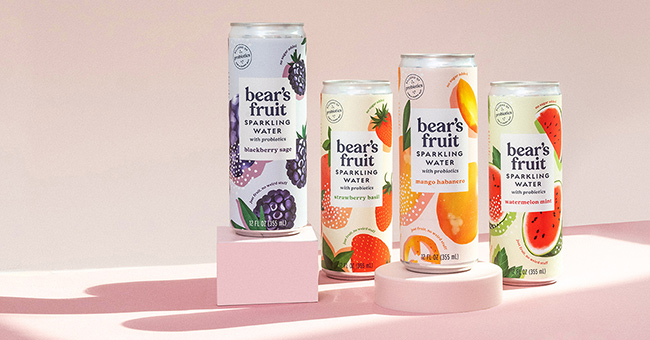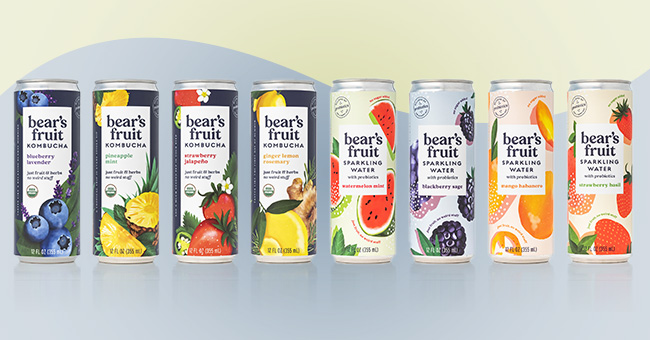After a challenging start to the year that included a supply-chain induced packaging change and construction related out-of-stocks, functional beverage maker Bear’s Fruit is ready to bloom.
This month, the New York-based company launched Bear’s Fruit Sparkling Water with Probiotics, its first non-kombucha line.
According to co-founder Amy Driscoll, the functional sparkling water line has been in development for over two years. Although the launch comes as gut health friendly functional soda products gain traction in the market, Driscoll stressed that the new drinks are a different proposition; Bear’s Fruit’s sparkling waters are made with the Bacillus subtilis probiotic strain that naturally occurs in the human gut and the drinks are flavored with organic juice and fruit purees, similar to Spindrift.
“We never had intended for Bear’s Fruit to only be a kombucha company,” Driscoll said. “We are still using, like our kombucha, 100% organic fruit and fresh herbs, but the shelf stability definitely changes the game a bit. And for us, our goal from day one was to develop the best tasting, sparkling water period, and then the functionality was layered in there.”
Calling the space for prebiotic sodas, water kefirs and kombucha-based tonics the “functional fizz set,” Driscoll noted that Bear’s Fruit’s sparkling waters will require little consumer education as probiotics are widely understood already, whereas consumers are still becoming familiar with prebiotics. However, while functionality is the core differentiating factor for the line, Driscoll said the brand intends to tailor messaging around flavor and refreshment with gut health being a value-add benefit.
Available in Mango Habanero, Strawberry Basil, Watermelon Mint and Blackberry Sage varieties, the shelf-stable drinks are packaged in 12 oz. slim cans. They are available online direct-to-consumer for $41.88 per 12-pack and have also launched brick-and-mortar in all Whole Foods Northeast stores for $2.99-$3.49 per can. In Whole Foods, the sparkling waters are merchandised in the functional cooler set next to Bear’s Fruit’s kombucha line.
“What’s important for us to reiterate is that this is different from anything else on shelf today — it’s not a prebiotic soda, and it’s not fermented like water kefirs or kombucha-based tonics,” she said. “There’s nothing wrong with those, but this is just a different product. We’re giving people the taste of a crushable sparkling water, but with gut health benefits. If you weren’t looking at the packaging, you wouldn’t know you’re drinking a functional beverage, which was our goal.”
In addition to the new line, Bear’s Fruit has also rolled out a rebrand for its core kombucha offerings, moving from glass bottles to cans. The change was not previously planned as the company had just introduced a new look for its flagship drinks last year. Instead, Driscoll said the rebrand came out of necessity after the price of glass bottles doubled; minimum orders were increased to 2.5 million units with an eight month lead time. “It was a hard pass,” she added.
However, the move to cans was fortuitous, she said. Driscoll noted that the new format is more sustainable, has less spoilage and is easier to ship, which helps the ecommerce side of the business.
“We weren’t really planning to change the kombucha, [the packaging] was going to be a way to distinguish the two lines,” she said. “But we were really pleasantly surprised with how they work together on shelf, they really complement each other. And it’s also efficient – you’re buying one package for both lines.”
The sparkling water launch comes after a tumultuous six months for Bear’s Fruit, when a move to a new Brooklyn facility halted production for several months. According to Driscoll, the company faced a three-month legal maze at the beginning of the year to secure the 5,500 square foot facility in Brooklyn’s Carroll Gardens neighborhood; the building had previously been occupied by a company that had gone out of business, requiring complicated negotiations with the prior tenant’s bankruptcy lawyers.
But once Bear’s Fruit secured a 10-year lease on the facility and moved in on March 1, the company discovered the gas line needed to be replaced. Ultimately, Bear’s Fruit opted to convert the building to electrical heat, but the lengthy construction period led to prolonged out of stocks, Driscoll said.
“[It’s] the growing pains that everyone experiences as you scale a brand, but they have been very, very real this year,” she said. “And it’s not fun to turn down POs and to tell customers that you’re going to be out of stock for, in some cases, a couple months. Just having to prioritize how we use our inventory as we’re growing, and there is more demand for Bear’s Fruit now than there ever has been before.”
Driscoll said communication and honesty with customers was key to surviving the out of stock, and noted that in the context of the global supply crisis more retailers have been understanding of brands struggling to meet demand.
Now, Driscoll said the disruption is in the past and products are back on shelves. The new plant is 3.5x the size of Bear’s Fruit’s previous location and also includes a tap room for on-premise sales. As the company settles into the new location, it is now preparing to increase output by 200% in the coming weeks. The company also plans to expand its team and is currently seeking to fill production line positions in the near future.
The brand is currently available in about 600 stores nationwide and with manufacturing back in order Driscoll hopes to begin expanding the retail footprint.
“We’re firm believers in our tagline that hard work bears fruit,” she said. “What you put in, you get out and we’ve put our heart and soul into this year to make things happen.”

